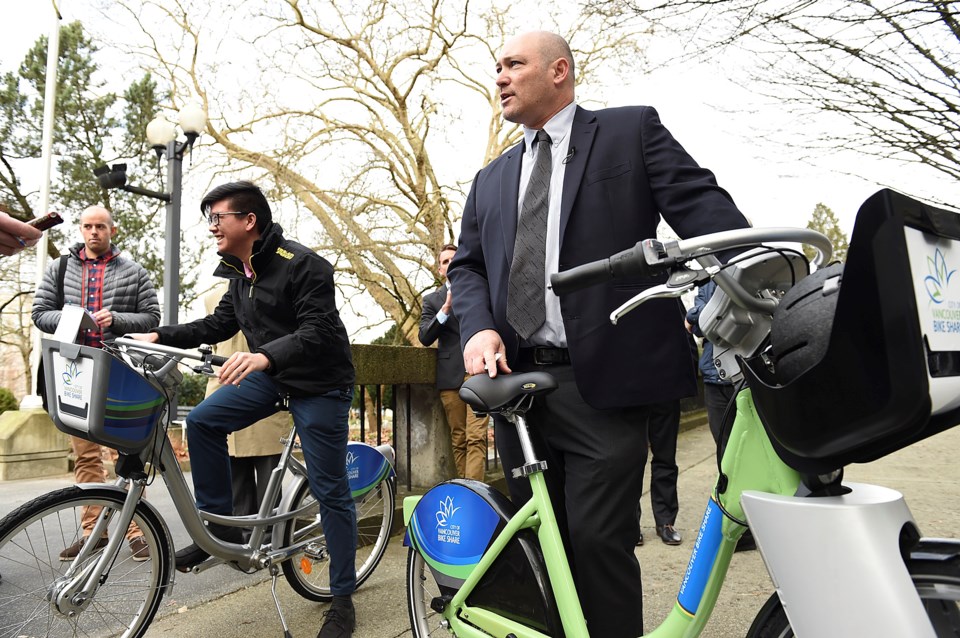Well, it took long enough. But Vancouver is finally joining the rest of the world as a city that offers both residents and visitors a bike-sharing program.
At last count (spring of 2015) there were 850 bike share programs around the globe from New York to Melbourne to Paris and even a few cities in China. Virtually all of those had been started up in the past decade.
There are a couple of reasons we came late to this party, not the least of which is the fact that the first company we tried to do business with went belly up. But what has also undeniably slowed the process is the insistence the supplier of this bike rental system provides helmets, even though those helmets will be free, part of the rental price.
That demand that riders use helmets, by the way, has been universally seen as one that has inhibited users of this system. And it may have that effect here. It is blamed for the low bike usage in Australia and, according to one report, “as a preemptive move to boost usage levels, Tel Aviv and Mexico City repealed their mandatory helmet laws.”
That aside, over the past two decades, Vancouverites have had a kind of love-hate relationship with bikes. It was back in 1996 that the city first decided to shut down one car lane on the Burrard Bridge and open it up for cyclists in what was supposed to be a six-month trial.
Traffic jammed. Motorists were loud and livid. The experiment lasted a week.
A decade later, plans were discussed to do it again. But the centre-left COPE council of the day was defeated by an NPA one that campaigned against the plan.
The tipping point came a few years later with the election of Vision, which actually promised to give it another try and won the approval of a younger, greener more bike-friendly electorate — an electorate that would embrace what became known as the “sharing culture.” (Car-sharing is booming here.)
Council proceeded with a more deliberate and more carefully planned strategy to once again cut out one lane of traffic on the Burrard Bridge. Pedestrians would also lose one sidewalk to cyclists.
And while the media was there on that fateful morning of July 13, 2009, their cameras loaded, tape recorders at the ready and expecting all hell to break loose, there was hardly a whimper from the motoring public.
There was more pushback from business interests when council continued by putting separated bike lanes down Hornby and along Dunsmuir, but that too settled down without much evidence of the economic disaster that was predicted. And no amount of criticism deterred a now firmly-determined council from shutting down Point Grey Road to through traffic in favour of cyclists and joggers.
Criticism during the subsequent municipal election coming for the NPA crowd about bike lanes had insufficient traction to cause any serious political damage and the wheels continued to grind on, albeit slowly, to achieve a deal on a bike-share program.
At last month’s announcement of the bike-share program, Charles Gauthier of the Downtown Business Improvement Association, who had been a critic of previous intrusions by cycling infrastructure on the flow of car traffic, actually expressed his support for the program.
Businesses have figured out how to market to cyclists.
News there was to be a major renovation starting up this month on the Burrard Bridge that would reduce motor traffic by yet another lane to provide more space for cyclists, played well back in the pages of the daily papers.
Editorialists are encouraging motorists to appreciate that this is a win for both cyclists and car drivers because fewer cars will be on the now congested roads. Money lost because of time wasted in traffic jams — “$40 million a year in wasted fuel and air pollution from almost 800,000 commuter vehicles a day” in Metro alone, according to the Vancouver Sun, will now be reduced.
Bike share programs are not simply a tourist attraction — they have become part of the transportation infrastructure. In many cities a significant portion of the users are heading to or from work. That will likely be the case here too as the culture continues to adapt to a more densely populated city.
twitter@allengarr



